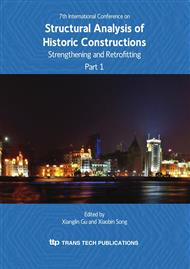[1]
Camplani, M, Cannas, B, Carcangiu, S, Concu, G, Fanni, A, Montisci, A, and Mulas, ML (2008). Acoustic tomography for non destructive testing of stone masonry., in: Lecture notes in Computer Science. 5073: 596-605. Springer Berlin/Heidelberg.
DOI: 10.1007/978-3-540-69848-7_48
Google Scholar
[2]
Crosatti, A, Piazza, M, Tomasi, R, and Angeli, A (2009). Refurbishment of traditional timber floor with inclined screw connectors., in: Proc. prohitech09, 1st Int. Conf. Rome, 21-24. 12. (2009).
Google Scholar
[3]
EN 1194 (1999). Timber structures. Glued laminated timber. Strength classes and determination of characteristic values. European Committee for Standardization. Brussels.
DOI: 10.3403/01544431
Google Scholar
[4]
EN 13183-2 (2002). Moisture content of a piece of sawn timber - Part 2: Estimation by electrical resistance method. European Committee for Standardization. Brussels.
DOI: 10.3403/02561842u
Google Scholar
[5]
ICOMOS (2001). Recommendations for the analysis, conservation and structural restoration of architectural heritage. [Online]. Available: http: /www. internation. icomos. org/charters/struc.
Google Scholar
[6]
Piazza, M, Riggio, M, Tomasi, R, and Angeli, A (2009).
Google Scholar
[7]
Solli, KH (2000). Modulus of elasticity - local or global values., in: Proc. of World Conference on Timber Engineering, Whistler Resort, British Columbia, Canada, July 31 - August 3, 2000 Tures_e. pdf.
Google Scholar
[8]
Turrini, G., and Piazza, M. (1983). Il comportamento statico della struttura mista legno calcestruzzo, in Recuperare: 6.
Google Scholar
[9]
UNI 11035-1 (2003). Structural timber. Visual strength grading: terminology and measurement of features. UNI Milano.
Google Scholar
[10]
UNI 11035-2 (2003). Structural timber. Visual strength grading rules and characteristic values for Italian structural timber population. UNI Milano.
Google Scholar
[11]
UNI 11118 (2004). Cultural heritage - Wooden artefacts - Criteria for the identification of the wood species. UNI Milano.
Google Scholar
[12]
UNI 11119 (2004). Cultural Heritage - Wooden artifacts - Load-bearing structures - On site inspections for the diagnosis of timber members. UNI Milano.
Google Scholar
[13]
UNI 11138 (2004). Cultural heritage - Wooden artefacts - Building load bearing structures - Criteria for the preliminary evaluation, the design and the execution of works., UNI Milano.
Google Scholar
[14]
UNI EN 408 (2004). Timber structures. Structural timber and glued laminated timber. Determination of some physical and mechanical properties. UNI Milano.
DOI: 10.3403/30159970
Google Scholar


